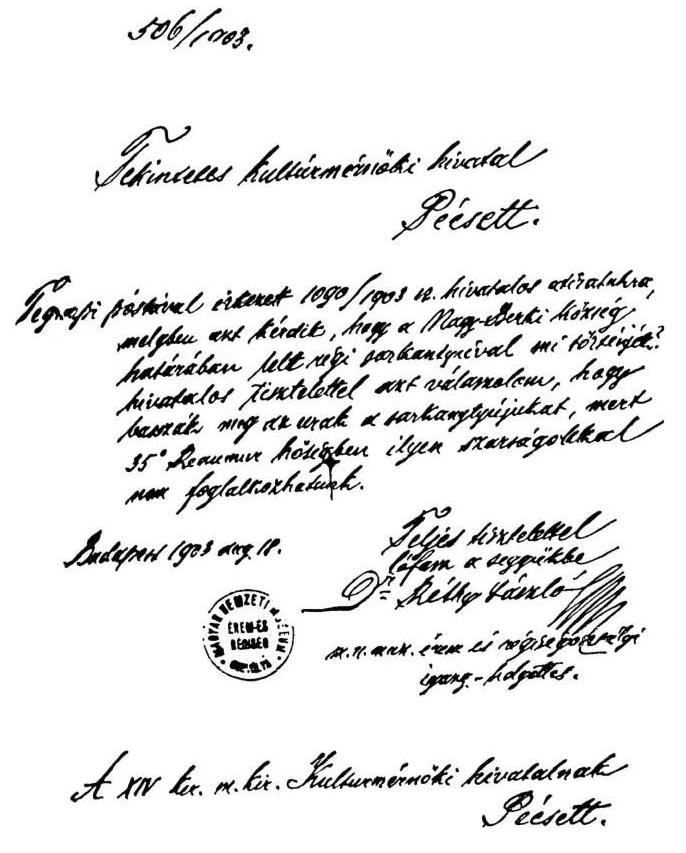How to write an official letter in Hungarian (forms of address)
 |
|
A letter from Dr.
László Réthy, 1903.
This is classic.[1]
[1] The
letter is formally addressed, etc, but it reads: “Further to your transcript
no. 1090/1903, received by yesterday’s post, regarding what should happen to
the old spur excavated near the border of the municipality of Nagy-berki, with official
respect I am giving the response that may you, my lords, go f*ck your spur as
we cannot address such bullshit matters in a heat of 35 Reaumur degrees. With
the utmost respect horse c*ck in your ass, Dr. László Réthy.” Source: http://www.foodandwine.hu/wp-content/uploads/2009/08/sarkantyu.jpg
|
A minute ago my brother
came into my room to ask me about how he should address a teacher assistant in
an email. His problem was that (a) the person whom he wrote isn’t a professor
but a teaching assistant (‘gyakorlatvezető’ in Hungarian – they’re not regarded
as “real” teachers, lecturers or professors), (b) and this teaching assistant
is young, so there isn’t a big age gap between him and my brother, and (c) he
even asked the students to use ‘tegeződés’ (i.e. informal speech) to address
him, but (d) – and this is a great BUT – by profession he is also a doctor,
meaning he has a respectful position[1]
in society. Points (a) and (d) are in contradiction with points (b) and (c),
and hence my brother’s hesitation: does the fact that the teaching assistant is
still a quasi-teacher and, moreover, a doctor, overrule his request to
informally address him?
The source of this whole
issue is the importance of the forms of address used in written communication.
Though there aren’t many forms of address in Hungarian (basically there are 3
forms, somewhat corresponding to speech levels), we always use them based on
numerous factors, such as the sender’s and the recipient’s age, social status,
job and personal relationship. It should be noted that each of these forms has
two sub-variants: a greeting form and a goodbye form. Now let’s see what these
three forms of address are!
1)
“Tisztelet”
Greeting form: Tisztelt
...!
Goodbye form:
Tisztelettel:
The most formal and
official form of address. Literally it translates as ‘respected XY’ and
‘Respectfully yours’. It is used to address unknown addressees (‘Tisztelt
Hölgyem/Uram!’, which is the same as the “Dear Sir/Madam” form in English; or ‘Tisztelt
Pályázó’ (‘Dear Applicant’)), as well as someone to whom you write in an
official matter or who is in a higher position and you’re not in a close
relationship. It has to be emphasised that after ‘Tisztelt’ you either put a
position name + Úr/Asszony/Kisasszony (so, for example, when you write to your
teacher, it becomes ‘Tisztelt Tanár Úr!’) or the addressee’s family name +
Úr/Asszony/Kisasszony.
Nowadays some people use
the “Tisztelt + full name” form, but it’s impolite and I always get the feeling
that the letter’s writer just wants to show off how well-mannered and polite he
is and how he wants to be familiar and friendly at the same time.
2)
“Üdvözlet”
Greeting form: Kedves
...!
Goodbye form:
Üdvözlettel: / Üdv:
A semi-formal version
that you can use with both ‘tegeződés’ and ‘magázódás’. The use of ‘Kedves’
(lit. ‘Dear’) presumes a closer relationship, i.e. the two of you are either on
good terms or in a working relationship covering almost daily (or, at least,
regular) co-operation. It is also acceptable to use this form in some other
cases, for example when you reply to a “Tisztelt Hölgyem/Uram!” form letter and
the recipient has the same position as you (like in the case of writing a
response to a job application).
The greeting form
consists ‘Kedves’ and the recipient’s given name, while the goodbye form
depends on whether you two are “in pertu”[2]
or not: ‘Üdvözlettel’ (lit. ‘Regards’, but it’s similar rather to ‘Best
regards’) is more formal, so if you aren’t “in pertu”, you should definitely
use this. ‘Üdv’ is the shortened variant of the former for ‘tegeződés’. Sometimes
‘Üdvözlettel’ is acceptable for also ‘tegeződés’: when you want to show your
respect for the other party or when you have a not-so-close relationship – you
know, ‘Üdv’ does presume a close(r)
relationship.
(In some cases a
position can follow ‘Kedves’ – for example, I address my former high-school
homeroom teacher with whom I have a close relationship as ‘Kedves Tanárnő’
(‘Dear Ms. Teacher’) instead of ‘Tisztelt Tanárnő’ (‘Respected Ms. Teacher’).
And to my former classmates and fellow university students: no, addressing a
university professor as ‘Kedves Tanár Úr!’ is not acceptable. It’s impolite.)
3)
“Szia”
Greeting form:
Szia(sztok) / Szervusz(tok) ...!
Goodbye form: Üdv
And the third one – for
‘tegeződés’ only and only between close acquaintances and friends. The greeting
form is usually ‘Szia’, ‘Szervusz’ is a little-old fashioned and more formal;
and ‘Üdv’ is put on the end, that’s why I emphasised the connection between
‘Üdv’ and familiarity.
+ a bonus:
‘Köszönettel’ (lit. ‘Thanks’)
is a universal goodbye form that you can use with all three forms. It has
another variant, ‘köszi’ to go with “szia” – but only “szia”, as its use with “szervusz”
would be questionable, given the slightly formal feeling of “szervusz”.
Thank you for reading!
Alla
Comments
Post a Comment